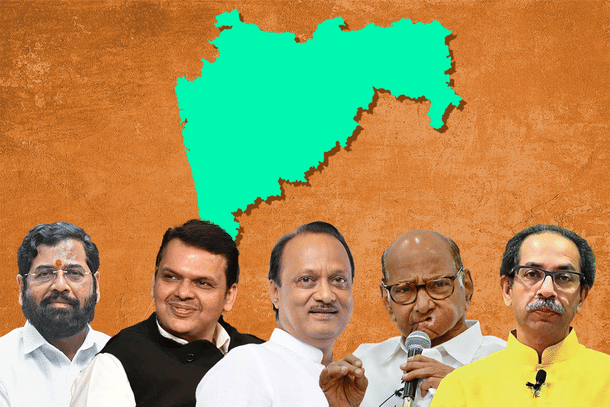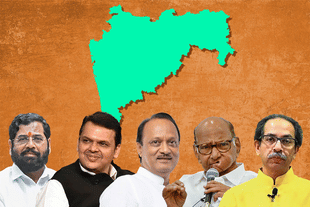Politics
Five Factors That Can Influence The Lok Sabha Verdict In Maharashtra
Krishna Dange
May 24, 2024, 10:31 AM | Updated May 24, 2024, 01:10 AM IST
Save & read from anywhere!
Bookmark stories for easy access on any device or the Swarajya app.


In the ongoing Indian general elections, polling for the Lok Sabha seats in Maharashtra was held in five phases from 19 April to 20 May.
On 4 June, the results day, the number of Lok Sabha seats won by the ruling NDA (National Democratic Alliance) as well as those won by the constituents of the INDI-Alliance in the state will be closely observed.
This is not just because the state sends 48 Members of Parliaments (MP) to the Lok Sabha, the second-highest state-wise, but also because the results of the same will determine the future of the original as well as that of the split factions of the two regional parties- the Shiv Sena and the Nationalist Congress Party (NCP).
While the Shiv Sena led by Eknath Shinde and NCP led by Ajit Pawar is in the BJP-led NDA, also known as Mahayuti in the state, the Shiv Sena (Uddhav Balasaheb Thackeray) led by Uddhav Thackeray and the NCP (Sharadchandra Pawar) led by Sharad Pawar are in the Congress-led INDI-Alliance, also known as the Maha Vikas Aghadi (MVA).
In the results for the 2014 Lok Sabha elections, the BJP-led Mahayuti had emerged as the coalition with the largest number of seats at 42 after nearly a decade. The coalition repeated its performance in 2019 collectively bagging 42 seats again.
However, erstwhile Uddhav Thackeray led Shiv Sena parting ways from the coalition in 2019 to form a ruling government in the state with the Congress led MVA had changed political equations. The political picture fractured further in 2022 and in 2023 with the formation of Shiv Sena UBT and NCP SP.
Considering that the results of the Lok Sabha elections will also set the tone for the upcoming state assembly elections and the municipal corporation polls, the outcome of the recently held polls will be closely watched.
Here are some of the key factors that can shape the outcome of the Lok Sabha polls for the ruling NDA as well as the INDI-Alliance in Maharashtra-
1) Maratha Caste Agitation
Marathas, the socio-politically dominant caste which comprises nearly 30-34 percent of the state’s population, has been demanding reservation for more than four decades.
After the 16 percent reservation granted separately to the community by the previous Devendra Fadnavis led Mahayuti government in the state was quashed by the Supreme Court in 2021, Marathas have been demanding the community's inclusion in the Other Backward Classes (OBC) category.
The protests led by the community leader Manoj Jarange intensified particularly after the BJP-led Mahayuti government came back to power in 2022. As of now, the state government under the premiership of Shiv Sena’s Eknath Shinde has placated the community by granting a separate 10 percent quota over and above the existing reservation for other categories. However, Jarange remains firm on the demand for including Marathas in the OBC category.
Although the community is not satisfied with the government’s provisioned quota, it is less likely to be the dominant factor across the state. This is so considering that the agitation is limited for now to its epicentre- a village named Antarwali Sarati located in Marathwada region’s Jalna District.
Barring the Lok Sabha constituencies like Beed, Jalna and Nanded, the community is less likely to vote on caste lines beyond the Marathwada region for now. The Maratha agitation is set to resume again post June 4.
2) Onion Export Ban And Other Agrarian Issues
The union government’s policy to impose 40 per cent duty on onion exports in August 2023 and its subsequent decision in December 2023 to ban the export of the same until April did not go down well with the farmers in Maharashtra.
This is more so considering that the state sees production of the red onion variety in large quantities and is also home to the largest onion market in the country located in Lasalgaon in the Nashik District.
Experts say that the union government has been intervening in the commodities market for more than a year, including that of the onion, considering the widely held assumption that onion and petrol price rise had contributed to the NDA government under Atal Bihari Vajpayee being dislodged from power in 2004.
Although the union government partially rescinded the onion export ban a few days after the Phase 1 polling, the farmers, particularly in the western Maharashtra continue to be disappointed.
This is apart from the farmers in Marathwada and Western Vidarbha who are disappointed with the union government's agencies for not procuring cotton this year and the state government for delay in starting procurement of soybean.
It remains to be seen whether the farmer’s discontent is transmitted into their voting patterns as there are a large chunk of marginal farmers who appreciate the union government’s farmer-centric schemes such as the PM Kisan.
The results from the Hatkanangale Lok Sabha seat, where the influential Swabhimani Shetkari Sanghatna’s (SSS) Raju Shetty is contesting against both Mahayuti and MVA candidates, will be telling.
Similarly, SSS’s Ravikant Tupkar is up against both coalitions in Buldhana. Additionally, the outcome from the onion-growing region of Nashik will indicate the extent to which the farmers are displeased with the NDA.
3) Sympathy For Uddhav Thackeray And Sharad Pawar
Eknath Shinde wresting control of the Shiv Sena from Uddhav Thackeray and Ajit Pawar asserting himself by taking control of the NCP from his uncle Sharad Pawar hasn’t gone down well with the supporters of the previous party chiefs.
This was evident from the emotionally charged rhetoric from Shiv Sena (UBT)’s side calling the Shinde-led Sena leaders as traitors and asking the voters to punish the candidates of the latter by refraining from voting for them.
On the other hand, NCP (SP) leaders like Rohit Pawar were seen shedding tears in the election rallies in support of his party’s candidates. Pawar, along with the party’s candidate for Baramati- Supriya Sule, appealed voters to stand by them and the party leader Sharad Pawar.
Such emotional appeals have found many takers particularly in the strong-holds of both parties.
However, on the polling day in each phase, it was seen that several voters who wanted to vote for Shiv Sena (UBT) and NCP (SP) ended up voting for the Shinde-led Sena’s polling symbol ‘bow and arrow’ and Ajit Pawar-led NCP’s ‘ticking clock’ owing to lack of awareness regarding the polling symbols of the newly formed rival parties.
4) Appeal Of The Double-Engine Sarkar
The BJP-led NDA throughout its campaign in Maharashtra had been banking on the three factors- the appeal of Prime Minister Narendra Modi among masses, labharthis i.e. beneficiaries of the union as well as state government’s schemes and the narrative of vikas i.e. development against bhrashtachar i.e. corruption.
However, considering that the response from the masses to its campaign in the state was not the same as the enthusiasm seen previously in 2014 and 2019, the BJP’s top leadership in the state is said to have appealed to Prime Minister Modi to hold as many campaign rallies in the state as possible.
The leader responded by holding 15 rallies across the five phases of the polling against nine rallies held in 2019.
The Mahayuti leaders believe that although the political arithmetic has become tricky with splits and defections, the infrastructure push by the union as well as the state government will pull the voters towards itself.
This was evident from NDA constituent Shiv Sena chief and Chief Minister Eknath Shinde reiterating in his rally speeches that he keeps several pairs of pens to ensure he manages to sign and clear all files related to public works without any delay.
5) Dalit And Minority Votes
Similar to their speeches elsewhere in other states, the INDI-Alliance party leaders in Maharashtra were seen claiming that if voted back into power, the BJP-led NDA would undo the reserved quota for scheduled castes (SC), scheduled tribes (ST) and the OBCs.
Although the BJP-led NDA was swift to allay fear of the same among the voters, the opposition rhetoric seems to have found many takers on the ground.
In case of Maharashtra, while the OBCs seem to be firmly in favour of the NDA, SCs constituting 12 percent, STs constituting 10 percent and Muslims who constitute 12 percent vote can be an important factor in certain constituencies where either of the categories along with the Muslims are in sizeable numbers.
At the same time, considering that the Prakash Ambedkar-led Vanchit Bahujan Aghadi (VBA) and the All India Majlis-e-Ittehadul Muslimeen have fought independent of each other, in most constituencies, a repeat of Dalit and Muslim votes coming together, as it had in 2019, will not be the case.
However, considering that the VBA supported INDI-alliance candidates on certain seats but went independent elsewhere, splitting of the Dalit vote will see either of the two major alliance’s candidates winning or losing on reduced margins.
Staff Writer at Swarajya





